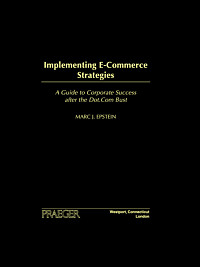Cover

| title | : | Implementing E-commerce Strategies : A Guide to Corporate Success After the Dot.com Bust |
| author | : | Epstein, Mark J. |
| publisher | : | Greenwood Publishing Group |
| isbn10 | asin | : | 027598463X |
| print isbn13 | : | 9780275984632 |
| ebook isbn13 | : | 9780313052262 |
| language | : | English |
| subject | Electronic commerce, Strategic planning, Business enterprises--Computer networks--Planning, Electronic commerce--Case studies. |
| publication date | : | 2004 |
| lcc | : | HF5548.32.E67 2004eb |
| ddc | : | 658.8/72 |
| subject | : | Electronic commerce, Strategic planning, Business enterprises--Computer networks--Planning, Electronic commerce--Case studies. |
Page i
Implementing E-Commerce Strategies
Page ii
This page intentionally left blank.
Page iii
Implementing E-Commerce Strategies
A Guide to Corporate Success after the Dot.Com Bust
MARC J. EPSTEIN

Page iv
Library of Congress Cataloging-in-Publication Data
Epstein, Marc J.
Implementing e-commerce strategies : a guide to corporate success after the
dot.com bust / Marc J. Epstein
p. cm.
Includes bibliographical references and index.
ISBN 0-275-98463-X
1. Electronic commerce. 2. Strategic planning. 3. Business enterprises
Computer networksPlanning. 4. Electronic commerceCase studies.
I. Title: Implementing e-commerce strategies. II. Title.
HF5548.32.E67 2004
658.872dc22 2004049568
British Library Cataloguing in Publication Data is available.
Copyright 2004 by Marc J. Epstein
All rights reserved. No portion of this book may be
reproduced by any process or technique, without the
express written consent of the publisher.
Library of Congress Catalog Card Number: 2004049568
ISBN: 0-275-98463-X
First published in 2004
Praeger Publishers, 88 Post Road West, Westport, CT 06881
An imprint of Greenwood Publishing Group, Inc.
www.praeger.com
Printed in the United States of America

The paper used in this book complies with the
Permanent Paper Standard issued by the National
Information Standards Organization (Z39.48-1984).
10 9 8 7 6 5 4 3 2 1
Page v
Contents
Companies Profiled | vii |
Preface | ix |
IIncreasing the Return on E-Commerce Investments | |
| Characteristics of E-Commerce Success | |
| Corporate and Functional E-Commerce Leadership | |
| Formulating an E-Commerce Strategy | |
| Organizational Structure and Design for E-Commerce | |
| Management Systems for E-Commerce Success | |
| Measuring the Payoffs of E-Commerce Investments | |
IICompany Cases | |
| Company Cases: B2CRetail | |
| Company Cases: B2CServices | |
| Company Cases: B2B | |
| Achieving Success in E-Commerce | |
Page vi
Page vii
Companies Profiled
Sector: Retail
Industry: Bookstores
Amazon
Barnes and Noble
Borders
Industry: Discount Retail
Wal-Mart
Kmart
Target
Industry: Luxury Retail
Nordstrom
Neiman Marcus
Ashford.com
Industry: Grocers
Tesco
Webvan and Homegrocer
DAgostinos-MWG
Industry: Office Supplies
Office Depot
Staples
Page viii
Sector: Services
Industry: Stockbrokers
Charles Schwab
Merrill Lynch
E*Trade
Industry: Consumer Banks
Wells Fargo
Bank of America
Bank One-Wingspan
Industry: Pharmacies
CVS
Walgreens
RiteAid-Drugstore.com
Industry: Postal Services
UPS
Federal Express
Sector: B2B
Industry: Computers
Dell
Compaq/HP
Industry: Networking
Cisco
Lucent
Industry: Plastics
GE Plastics
Omnexus
PlasticsNet.com
Page ix
Preface
With the growth of the Internet, corporations have struggled with the determination of the appropriate level of investment in the new technology. CEOs faced the quandary of whether to fully commit or wait and watch. Academics devoted effort to determining ways to formulate e-commerce strategies. But, little research has focused on how to choose among alternative strategies or how to execute an e-commerce strategy.
This book relies on extensive analysis of academic and managerial research, along with a review of company successes and failures during the foundation and short history of e-commerce. It provides industry and company cases and specific recommendations for actions that managers can take to improve e-commerce success. It provides a framework for measuring the benefits and costs of potential e-commerce investments that can aid in deciding how much to invest and how to achieve the greatest potential payoffs. It places e-commerce in a value creation frame, so that corporate and business unit managers can more effectively evaluate the possibilities and trade-offs. The author hopes that lessons learned can guide managers to effectively formulate, evaluate, and implement an e-commerce strategy.
This book could not have been completed without the important contributions of research assistants Todd Makse, Steve Wilbur, Kirby Brendsel, and Pranika Uppal. The dedication of faculty assistant Karen Lavelle has been critical in managing all of the documents related to the preparation of this book. I also thank Nick Philipson, senior editor at
Page x
Praeger, for his support, guidance, and friendship over the years of our association. Finally, I acknowledge my colleague and friend, Al Napier, who was an important inspiration to this project and provided significant input throughout the project.
The book is dedicated to the many managers whom I have worked with who have asked about evaluating both potential e-commerce investments and e-commerce success. The lessons we learn from prior successes and failures and the frameworks presented here are intended to help senior general managers to better develop, evaluate, and implement e-commerce strategies. IT managers should be aided to better analyze the value creation potential of investing additional resources in e-commerce initiatives. I hope also that for students and researchers this book pulls together the managerial experiences and academic literature on the formulation, implementation, and evaluation of e-commerce strategies and that it adds to the understanding of management control and performance measurement in corporations. If some find its synthesis, frameworks, and guidance useful, this book will be a success.
Next page








